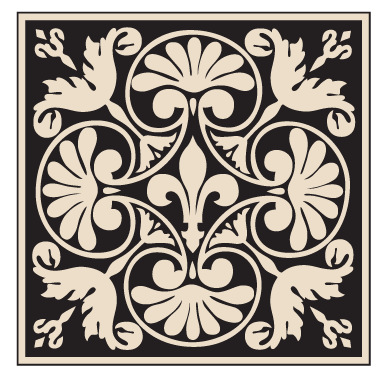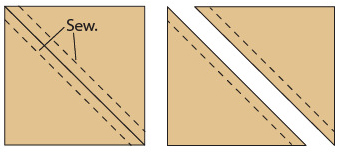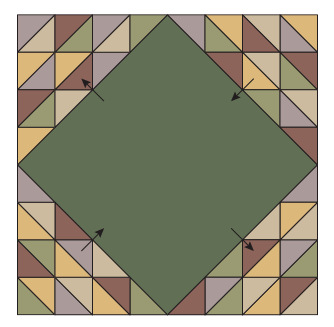

You may have the universe if I may have Italy.
—Giuseppe Verdi
Echoes of Italy Table Runner
Finished Birds in the Air blocks: 8˝ × 8˝
Finished table runner: 24˝ × 72˝
Echoes of Italy’s inspiration is from the past. It is a mixed-medium textiles project that uses 23 different fabrics with multiple textures and weaves. Project fabrics included 2 silk dupionis, silk matka, Radiance silk/cotton blends, 5 varying grades of home decor textiles, a batik, and 8 traditional cottons. Echoes can be constructed as either a bolster or a runner. The palette is drawn from the rolling hills of Italy at dusk.
I have long been intrigued by the patterns in the floors, windows, and architectural details throughout Europe. Echoes of Italy’s appliqué motif was inspired by the Cathedral of Santa Maria Assunta in Italy. The almost feather-like quality of the appliqué design was inspired by a motif found in the tile patterns and the ornamentation that can be found throughout the cathedral. The use of the Birds in the Air blocks is evocative of the mosaic floors of the Basilica di Santa Maria Maggiore in Rome. By incorporating the leaves into the body of the project and appliquéing them off the traditional “background” of the central medallion, I was mimicking yet another architectural detail: a carved soffit or cornice. Marrying it all together surely is an echo of Italy.
Read Exploring New Textiles: Eclectic Fabric Guidelines before beginning.

Floor tile in Cathedral of Santa Maria Assunta, Italy

Materials
FABRICS FOR BLOCKS AND BORDER
Mixed-medium fabrics: 1¼ yards total of 18 fabrics for half-square triangles (Each piece should measure at least 3˝ × 27˝ or 6˝ × 14˝.)
Green plaid wool (54˝–60˝ wide): ½ yard for Birds in the Air blocks (If your fabric is wider than 56˝, you will need only ¼ yard.)
Bronze textured silk matka: 1 fat quarter (18˝ × 20˝) or ½ yard for appliqué background
Brown chenille upholstery: 2 yards, cut lengthwise, for borders without seams or ¾ yard, cut across the width of fabric, for borders with seams
HAND-DYED WOOL FOR APPLIQUÉ
Garnet, dark plum, and seal brown: 8˝ × 10˝ each for medallion
Gold: 6˝ × 8˝ for medallion and small oval accents
Green: Approximately 8˝ × 22˝ for leaves
OTHER MATERIALS
Interfacing for hand-dyed wools and silks
Color-coordinated wool thread for appliqué
Backing: 1½ yards
Binding: ½ yard
Batting: 32˝ × 80˝
Cutting
MIXED-MEDIUM FABRICS
• From each of the 18 fabrics, cut 7 squares 2⅞˝ × 2⅞˝ for the pieced triangle blocks. Cut 1 additional square 2⅞˝ × 2⅞˝ from one of the fabrics.
Choose 32 of the lighter-weight squares and cut in half diagonally.
GREEN PLAID WOOL
• Cut 6 squares 8⅞˝ × 8⅞˝; cut in half diagonally.
BRONZE TEXTURED SILK MATKA
• Cut 1 square 14˝ × 14˝.
BROWN CHENILLE UPHOLSTERY
• Cut 2 strips 4½˝ × 64½˝. They can be cut on the lengthwise grain or pieced from 3 or 4 strips 4½˝ × width of fabric.
• Cut 2 strips 4½˝ × 24½˝.
BINDING
• Cut 5 strips 2½˝ × width of fabric.
TIPS
• To improve accuracy, you can cut the mixed-medium squares for the half-square triangle units 3˝ × 3˝ and trim them down after sewing.
• The heaviest of the home decor fabrics will be the hardest to press adjacent to the wool. Don’t cut these diagonally.
Construction
All seam allowances are ¼˝ unless otherwise noted. Fabrics are paired right sides together. Prepare all the fabrics before you cut; refer to Exploring New Textiles: Eclectic Fabric Guidelines. Interface all silks and unstable weaves.
HALF-SQUARE TRIANGLE UNITS
There are many ways to construct half-square triangle units. What follows is a traditional method. The focus of this project is to make the units scrappy; you do not need to worry about a light/dark rhythm in the pairing of the fabrics, although some contrast is encouraged. Pair them based on both color and weight. Avoid putting two heavy fabrics together—weight is a greater issue than fiber content when piecing with eclectics. How fabrics will press is actually the first consideration when pairing. How they come together in the block is secondary.
1. Choose at least 48 pairs of 2 squares each from the 2⅞˝ mixed-medium squares. If you use more squares, you’ll have more choices when you assemble the table runner, with some left over for another project. Draw a diagonal line from corner to corner on the wrong side of the lighter-weight, smoother-textured square of each pair.
2. Layer the squares of each pair right sides together and sew ¼˝ on each side of the drawn line.

Half-square triangle units
TIP • A walking foot or even-feed foot is helpful for some of the heavier textures but is not mandatory. By pairing a cotton with a specialty fabric and drawing the diagonal line on the cotton, you will be feeding the pair through your machine with the specialty fabric on the bed of the machine. This helps with both nap issues and stretch.
3. Cut on the drawn line and press. Traditionally, we press away from light-colored fabrics. In eclectics, press away from the heavier of the 2 fabrics you have paired. In the case of the home decor textiles, you may have greater success pressing the seams open.
4. The half-square triangle units will measure 2½˝ × 2½˝. Make 96.
BIRDS IN THE AIR BLOCKS
The Birds in the Air blocks are assembled using the mixed-medium half-square triangles and the green plaid wool triangles. The intent is to have these blocks read scrappy. Light and dark color placement does not need to be consistent, but, as always, the decision is yours to make. Half of this block is solid, and half is pieced from the 2½˝ half-square triangle units and the diagonally cut triangles. You will assemble sixteen large pieced triangles for your project; twelve will be combined with the green plaid wool triangles to complete the Birds in the Air blocks, and four will surround the appliquéd background.
1. For each pieced triangle, select 6 mixed-medium half-square triangle units and 4 mixed-medium triangles. Arrange the units and triangles in 4 rows, following the pieced triangle assembly diagram.
Row 1: 3 half-square triangle units and 1 triangle
Row 2: 2 half-square triangle units and 1 triangle
Row 3: 1 half-square triangle unit and 1 triangle
Row 4: 1 triangle

Pieced triangle assembly
2. Using a walking foot or even-feed foot, sew the units together in rows. Press the rows in alternating directions.
3. Sew the rows together as shown. Press the seams toward the block centerline. Once all 16 of the pieced triangles are assembled, set aside 4 for use around the appliqué background, and finish the assembly of the Birds in the Air blocks.
4. Sew together 1 green plaid wool triangle and 1 large pieced triangle. Place the pieced triangle on top of the wool as you feed it through your machine. The wool will be on the bed of the machine. This will allow you to see and control the joins on the pieced section as you sew and help in minimizing the stretch of the wool.
5. The block will measure 8½˝ × 8½˝. Make 12.

Birds in the Air block
Appliqué
Refer to Wool Appliqué … My Way.
1. Prepare the appliqué pieces in the quantities indicated using the project patterns.
TIP • For the circles, I sometimes draw directly onto the freezer paper with an architectural circle template, a tool left over in my crayon box from my first design life! You may prefer to do the same.
Note: The textured silk matka used for the appliqué background has a looser weave than many silks. It would benefit from being stabilized with a lightweight interfacing like Touch O’Gold II. I chose the black version of this interfacing so that the color would not be seen on the face of the finished project.
2. Prepare the background square. The 14˝ bronze textured silk matka square is oversize. To ensure that your appliqué will fall well within the trim area, mark the 12˝ × 12˝ trim line with either chalk or a line of hand-basted stitching in contrasting thread. Textured silk matka does tend to fray. Zigzag the edges on your machine or stabilize with the method of your choice before you begin the appliqué work.
3. Find the center of the block. Following the project photographs, lay out all the appliqué medallion pieces.
4. Appliqué the feathers, starburst points, and circles, working from the center out.
5. Re-center your design within the 12˝ × 12˝ design area, if necessary, and trim the appliquéd background to 11¾˝ × 11¾˝. The remaining leaves and circles in the body of the project will be appliquéd after the blocks are joined together.
Assembly
1. Add the 4 remaining pieced triangles to the appliquéd medallion background. Refer to the appliqué block assembly diagram. The background is now on point. Depending on the weight of the fabrics in the seam, press the seams open or toward the center on 2 parallel sides and away from the center on the 2 remaining sides. The completed medallion appliqué block will measure 16½˝ × 16½˝.

Appliqué block assembly
2. Join the 12 Birds in the Air blocks into 6 columns of 2 blocks each. Rotate the blocks so that they are oriented as shown.

Table runner assembly
Note: The appliquéd block was intentionally offset from the center in this project.
3. Sew the columns together as shown. Press the joining seams open.
TIP • I have discovered that an old-fashioned tailor’s tool called a clapper is a great asset for pressing wool and home decor seams open. The result is flatter and more stabilized seams, making for a much smoother project face. Why it works is pure science and beyond my ability to explain, but it has to do with the combination of the porousness of the wood tool, steam, and pressure. The Steady Betty offers a version of it that works really well, too.
4. Appliqué the remaining circles and leaves to the chevron areas created by the secondary patterning of the joined blocks.
5. Sew the 2 brown chenille upholstery 64½˝ strips to the long sides of the project. Home decor fabrics like the one I chose have a nap and will tend to move away from the seamline as you sew. Use a walking foot or even-feed foot and place the chenille fabric on the bed of the machine as you stitch. Watch the raw edges to keep them aligned. Press the seams open.
6. Sew the 2 brown chenille upholstery 24½˝ strips to the short edges of the project. Press the seams open. The top will measure 24½˝ × 72½˝.
Note: I am a strong advocate for early thought on the integration of the final quilting of a project. Quilting can be integral to the design of the whole project and does not serve just as a means of holding the three quilt layers together. I wanted the chevron ele-ments of the Echoes of Italy Table Runner to mirror the lines of carved-wood moldings, and the quilting on our sample delineates those lines. The leaves are appliquéd but could just as easily have been drawn with the quilter’s needle.
Finishing
1. Layer, baste, and quilt as desired.
2. Add binding.
TIP • Sew the binding strip to the face of the quilt top with a ¼˝–⅜˝ seam allowance, aligning the raw edges. Due to the thickness of the home decor fabric in the borders, a slightly deeper seam allowance may be beneficial.

For all printable patterns or digital content: http://tinyurl.com/11255-patterns-download